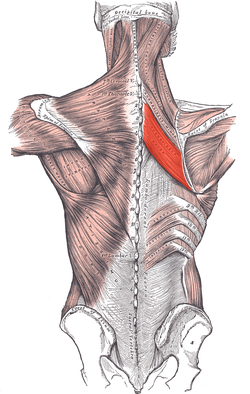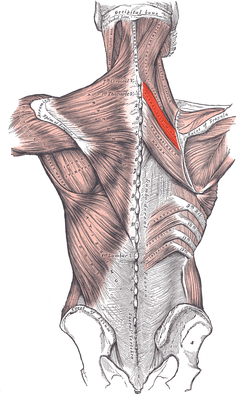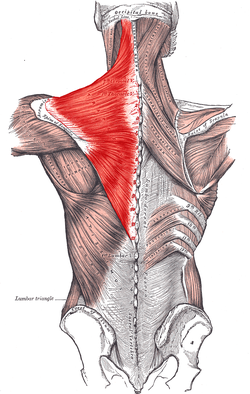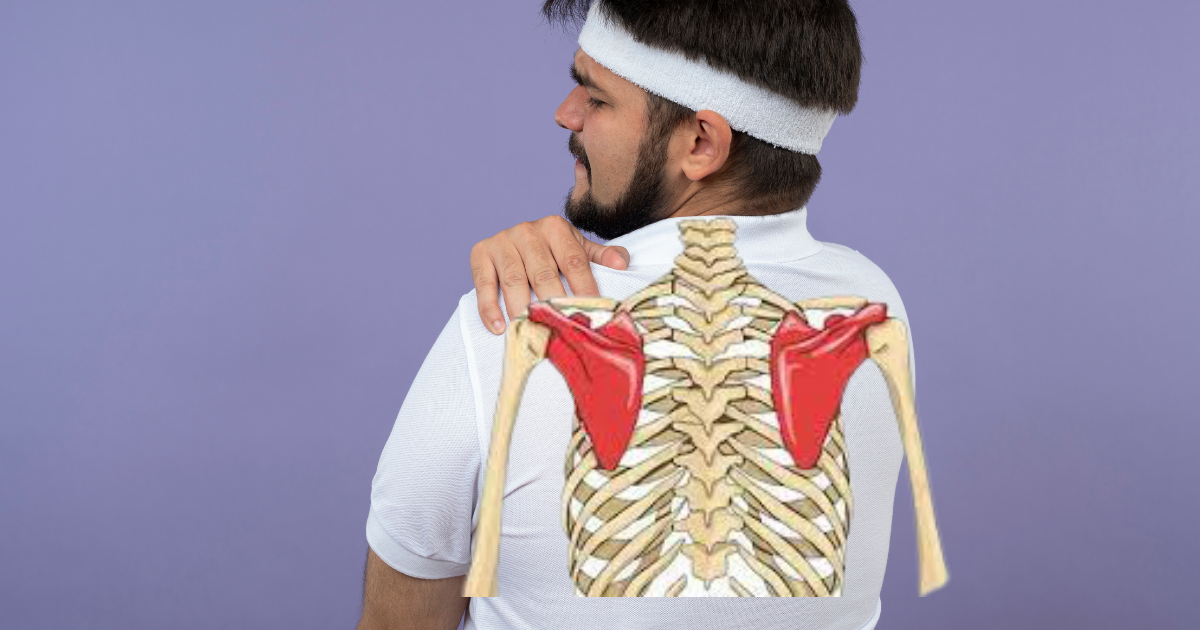Pain in my back between shoulder blades may be a common problem. The doctors referred to this discomfort as inter-scapular pain. Shoulder pain is characterized by dull pain, soreness, burning, or tingling.
As a patient, I may also have difficulty using the sensation of the affected arm or muscle pulling. In most cases, pain in my back between shoulder blades is not a cause for concern. But in some cases, this may indicate that the situation is more serious.
Anatomy of the shoulder blade
When considering pain in any part of the body, one should consider the structure of that part.
The shoulder blade is the triangular bone at the back of the shoulder (called the cap bone or scapula in medicine). Another name of the shoulder blade is scapula.
The upper arm bone is connected to the clavicle and has three muscle groups connected to it. These muscles help move the shoulder joints.
Muscles include the rhomboids, the middle, and lower trapezius muscles, all of which play a key role in keeping the shoulder blades moving forward and backward.
The shoulder blade has a wide range of movement. The muscles that connect the shoulder blade bone can make the shoulder rotate, move in a circle, move up and down, left and right.
Because the shoulder can move in many ways, it is easy to be injured, which may cause pain in the shoulder blade.
Unfortunately, shoulder blade pain is usually not as simple as injury-related pain. In some cases, shoulder blade pain is caused by pain in nearby organs in distress.
Muscles of the shoulder blade
Rhomboid muscles
The rhomboids are the two superficial muscles on both sides of the upper back. The rhomboid muscles are also called the rhomboids, are rhombus-shaped muscles associated with the shoulder cap bone (scapula). There are two rhomboid muscles 1) Rhomboid major muscle & 2) Rhomboid minor muscle on each side of the upper back.
The large muscle, located under the trapezius muscle in the upper part of the thoracic region of the back. Small muscles also participate in the movement of the shoulder cap bone in the same way.
Rhomboid major muscle
Origin: Rhomboid major muscle originates from the spinous processes of vertebrae T2-T5
Insertion: Medial border of shoulder cap bone (scapula)

Function:
- Supporting scapula
- Drawing scapula superomedially
- Rotating glenoid cavity inferiorly
Innervation: Dorsal scapular nerve (C4-C5)
Blood supply: Dorsal branch of upper five or six posterior intercostal arteries, dorsal scapular artery, deep branch of the transverse cervical artery.
Rhomboid minor muscle
Origin: Rhomboid minor originates from nuchal ligament, Spinous processes of vertebrae C7-T1
Insertion: Medial end of the spine of the scapula

Function: Same as Rhomboid major muscle.
- Supporting scapula
- Drawing scapula superomedially
- Rotating glenoid cavity inferiorly
Innervation: Dorsal scapular nerve (C4-C5)
Blood supply: Same as Rhomboid major muscle. Dorsal branch of upper five or six posterior intercostal arteries, dorsal scapular artery, deep branch of the transverse cervical artery.
Trapezius muscles
The trapezius muscles are large triangular, paired muscles located on the back of the neck and chest. When viewed together, the pair forms a diamond or trapezoid shape, hence the name.
The trapezius muscle and the latissimus dorsi, the rhomboid major and minor, and the levator scapula together belong to the superficial layer of the external back muscles.

Origin: External occipital protuberance, medial one-third of superior nuchal line, spinous processes of vertebrae C7-T12, Nuchal ligament.
Insertion: Acromion process, the spine of the scapula, and posterior border of the lateral one-third of the clavicle.
Function:
- Movement of the scapula
- Movement of the spine
Cause of the pain in my back between shoulder blades
- Bad posture
- Muscle injury
- Exercise
- Stress
- Slipped disc
- Lifting or carrying
- Scoliosis
- Trauma
- Osteoarthritis
- Pulmonary embolism
- Myofascial pain syndrome
- Heart attack
- Cancer
- Aortic tear
- Acid reflux
- Shingles
- Gall stone
Bad posture
Sitting in a bad posture for a long time will cause structural changes in your spine, which will eventually lead to pain under the shoulder blade.
Tilting your back, tilting your head down, or sitting on the side (for example, when working behind a desk or reading a mobile phone may weaken your muscles and put pressure on the discs, muscles, and ligaments.
This daily imbalance can cause upper back pain. There are also some postures that may strain your upper back muscles including:
- Sitting on a desk during most of the day
- Using an uncomfortable chair
- Crossing your legs when sitting
- For a long time leaning the laptop
These postures may cause a dull pain between the shoulder blades.
Muscle injury
The most common cause of pain between the shoulder blades is muscle injury (or strain). When muscle fibers are stretched and torn, muscle strain occurs, causing local bruising, swelling, and pain in the affected area.
Strain often affects the back, shoulders, and legs. If you do not perform heavy lifting correctly, sleep in a strange posture, or perform strenuous exercise, strain can occur.
The rotator cuff muscles are attached with the arm to the shoulder blade. Injury to one or more of these muscles can cause upper back and shoulder pain. These injuries can also cause difficulty in moving the arms or shoulders.
Exercise
Often heavy exercise may responsible for a muscle tear. And certain forms of exercise can increase the risk of upper back injuries.
Throwing the ball on the head, lifting weights and swimming, may strain the muscles between the shoulder blades.
Over time, the repetition of these movements is a common cause of muscle strain. Other symptoms of muscle strain include swelling, muscle weakness, and muscle cramps in the area.
Stress
Stress causes the muscles of the body to tense. The neck and shoulders are common areas of tension that can cause pain between the shoulder blades.
If the shoulder muscles are a stressed for a long time, the pressure can also cause headaches.
On the other hand, when we feel highly anxious or stressed, our body’s natural response is ten up. If this condition persists for a long time, it may cause muscle tension, which can lead to stiffness, stiffness, pain, and neck and shoulder pain.
Slipped disc
Your spine has a cartilage filling called an intervertebral disc. The disc is composed of two parts: a soft, squishy interior and a tough exterior.
Strain or injury of the spine can cause a bulging disc, called a herniated disc, slipping or bulging. Degenerative disc disease of the cervical and thoracic spine can cause pain in this area.
It is not uncommon for patients with cervical disc herniation to feel pain only in other parts, which may cause a delay in diagnosis.
Lifting or carrying
Lifting or carrying heavy objects can strain your upper back. People must be careful to use safe lifting methods when pushing, pulling, or lifting objects.
Carrying a shoulder bag puts weight on the shoulders and pulls the muscles between the shoulders.
Carrying a heavy shopping bag can also strain your arms and upper back muscles.
Scoliosis
Scoliosis is an abnormal curvature of the spine. It can cause deformities, muscle cramps, and shoulder and back pain.
It is usually mild and does not require treatment, although depending on the degree of curvature, physical therapy or a back brace can improve the condition. You can buy a back brace from amazon at an amazing price!
Trauma
Muscle trauma is caused by direct or blunt force damage to muscle fibers and connective tissue. It usually causes local pain, swelling, and bruising.
Muscle trauma is usually related to contact sports, falls, or vehicle accidents. Although severe tissue damage can prolong recovery time, the damage is usually mild.
Osteoarthritis
Over time, the gradual wear and tear of the joints can lead to osteoarthritis. Osteoarthritis is a chronic disease that causes pain, reduced range of motion, and joint stiffness, and it usually worsens with age.
Joint injury or overuse can increase the risk of osteoarthritis. Some people’s jobs require frequent overhead stretching or heavy work. This work may cause shoulder osteoarthritis and upper back pain later in life.
Arthritis of the neck and even the ribs can cause inter-scapular pain. Like intervertebral disc disease, even if there is no neck pain, neck arthritis can cause pain between the shoulder blades or other regions.
Pulmonary embolism
A pulmonary embolism occurs when a blood clot in the leg ruptures (deep vein thrombosis) and enters into the lungs. The blood clot blocked the pulmonary artery, causing shortness of breath and sudden sharp pain between the shoulder blades.
Some risk factors for pulmonary embolism include medical conditions such as cancer, long car or airplane travel, long bed rest, pregnancy, and recent surgery.
The pain is usually sudden, severe onset, and may be related to severe shortness of breath, although sometimes people only notice mild discomfort.
Myofascial pain syndrome
Myofascial pain syndrome is a chronic disease that causes pain in the musculoskeletal system. This pain is limited to specific areas.
For example, you may only feel pain and tenderness in your right shoulder and neck. Pain is usually related to trigger points in the muscles.
Unlike other chronic pain conditions, pain does not occur throughout the body. The trigger point of the muscle will cause pain in the area. In the upper back, it can cause pain in the muscle groups around the spine, neck, and shoulders.
Heart attack
Heart attacks don’t always start with chest pain, especially in women.
In studies of pain in patients with heart attack, 3% had pain confined to the area between the shoulder blades.
This pain is usually bothersome and may be accompanied by chest pain, shortness of breath, and dizziness.
Cancer
Lung cancer causes referred pain between the shoulder blades by pushing on the nerves in the upper part of the lungs.
Other cancers that can cause pain in this area include esophageal cancer, mesothelioma, lymphoma, and liver cancer.
Cancers that have spread to the neck bones such as breast cancers can cause pain between the shoulder blades and may not have other symptoms.
Aortic tear
Aortic dissection occurs when the wall of the aorta (the major artery of the body) ruptures, causing blood to enter the vessel wall and cut (or rupture) the lining of the wall.
Aortic aneurysms can cause shortness of breath, hoarseness or hoarseness of the voice, back pain, or pain between the left shoulder, or shoulder blade.
Aortic dissection can cause sudden and severe pain, and patients often feel like something has been torn or torn inside.
Acid reflux
Due to acid reflux, you may feel a burning sensation in the pit of the stomach or in the middle of the chest beneath the breastbone. Sometimes pain can be felt between shoulder blades or in the jaw or teeth.
The medical term for acid reflux is Gastroesophageal reflux disease (GERD). Symptoms of GERD may also include difficulty swallowing, and hoarseness.
Shingles
Shingle is a viral infection that causes a painful rash. Shingles can appear anywhere on the body but is usually a single blister that develops around the left or right side of the torso.
Shingle is caused by the varicella-zoster virus, the virus that causes chickenpox.
If you are affected by shingles then you may experience severe pain between your shoulder blade.
Gall stone
Pain in diseases of the gallbladder often pulsates between the shoulder blades and may be accompanied by pain and nausea in the upper right corner of the abdomen. Usually occurs after eating fatty foods.
Treatment of the pain in my back between shoulder blades
Medication
Some medications relieve pain and discomfort for the shoulder blade pain. This may include anti-inflammatory drugs such as ibuprofen. Steroids can be administered as pills or injections to reduce pain and inflammation. For some diseases of the shoulder blades, muscle relaxants and antidepressants are prescribed. But you should have to visit the doctors before taking any kind of drugs.
Rest
Sometimes, overworked muscles just need to be recovered and repaired, especially if you are always doing repetitive exercises or pushing your body beyond its limits. Sitting for a long time can be counterproductive, so please don’t eliminate physical exercise altogether. Instead, limit your active exercise and try gentler aerobic exercises, such as walking or light stretching.
Stretching
If you perform daily stretching then blood flow can increase to your muscles and joints of the shoulder, increase range of motion, and reduce pain. Stretching after a workout is always important to avoid injury, muscle tension, and overexertion.
Exercise
Exercise can strengthen the back area, thereby helping to relieve pain. Push-ups, pull-ups, and sit-ups are great ways to strengthen the back and abdominal muscles. Physical activity is important for overall health, so you should perform daily exercise though it is little.
Hot and cold therapy
Applying hot and cold compresses between the shoulder blades can reduce discomfort. It is usually best to wear it for 15 minutes every four hours. Buy hot and cold compression from Amazon!
Physical therapy
You may be referred to a physical therapist by your doctor. The physical therapist will assess your pain and teach you specific exercises and stretching exercises to improve your symptoms. The physical therapist may recommend you two exercises.
a) Cross-body stretch
b) Rounded-shoulders stretch
Remember, stretching is not the final treatment of shoulder blade pain. So keep following the doctor’s or physical therapist’s advice.
Prevention
The following criterion may help you to prevent pain between the shoulder blade.
- Avoid bad posture: When going to work or school, please try not to slack and maintain a good posture. You might consider using a seat cushion to help improve your sitting posture. Also, do not sleep in a strange posture, as this may cause pain in your shoulders.
- Avoid lifting heavy weights: Lifting heavy objects may cause injury and may cause pain between the shoulder blades. Avoid putting heavy bags on one shoulder. If you must lift something, be sure to bend your knees and try not to put too much pressure on your back.
- Live healthy living: Make sure you eat complete food, get seven to eight hours of sleep every night. According to the recommendations of the World Health Organization, ordinary adults should do at least 150 minutes of physical exercise a week. A healthy lifestyle can help you feel energetic and rested and can help you relieve pain.
- Don’t sit for too long: When working at a computer or desk, get up frequently and stretch your body. This can help you keep your muscles relaxed. You can also try a standing desk. You can buy a standing desk from Amazon.
FAQs
Why do I have pain in my upper back?
Upper and middle back pain can be caused by overuse, muscle strain, or damage to the muscles, ligaments, and intervertebral discs that support the spine. Poor posture puts pressure on the spinal nerves due to certain problems (such as a herniated disc.
How do I know if my upper back pain is serious?
If you have pain in your upper back, with numbness or weakness in your arms or legs. Then it may be serious for you! It may be due to nerve damage caused by a slipping disc. Your doctor can make a diagnosis through a physical examination.
Is pain between shoulder blades a sign of a heart attack?
Shoulder blade pain is sometimes a symptom of a heart attack, especially in women. Other signs may also appear, such as chest pain and shortness of breath. If you experience these symptoms, you should seek emergency medical treatment.
Can anxiety cause pain between shoulder blades?
When you experience a stressful event or an anxiety attack, your muscles sometimes contract violently. This is an automatic response or a reflex response. This is called a stress response or “fight or flight” response. It is a natural reaction of our body’s to tens up. If this condition persists for a long time, it may cause muscle tension.
Resources

